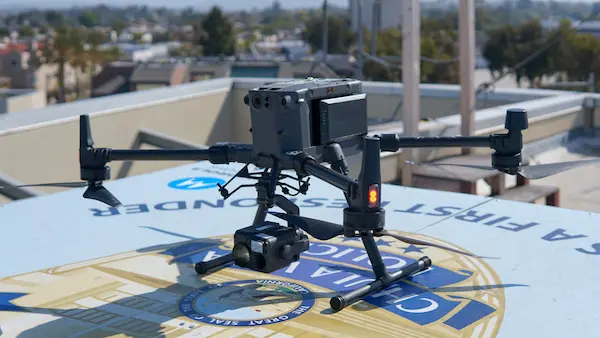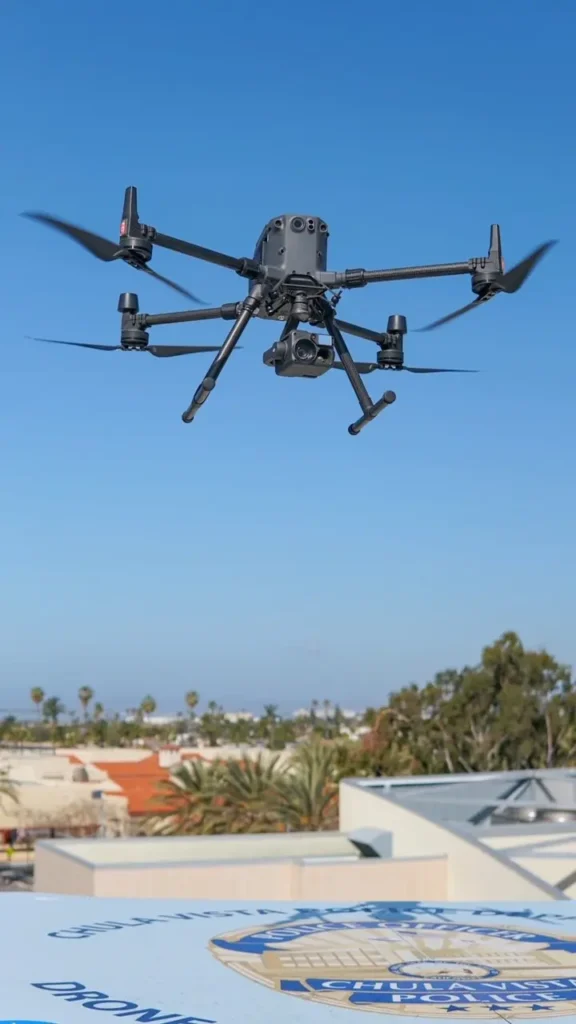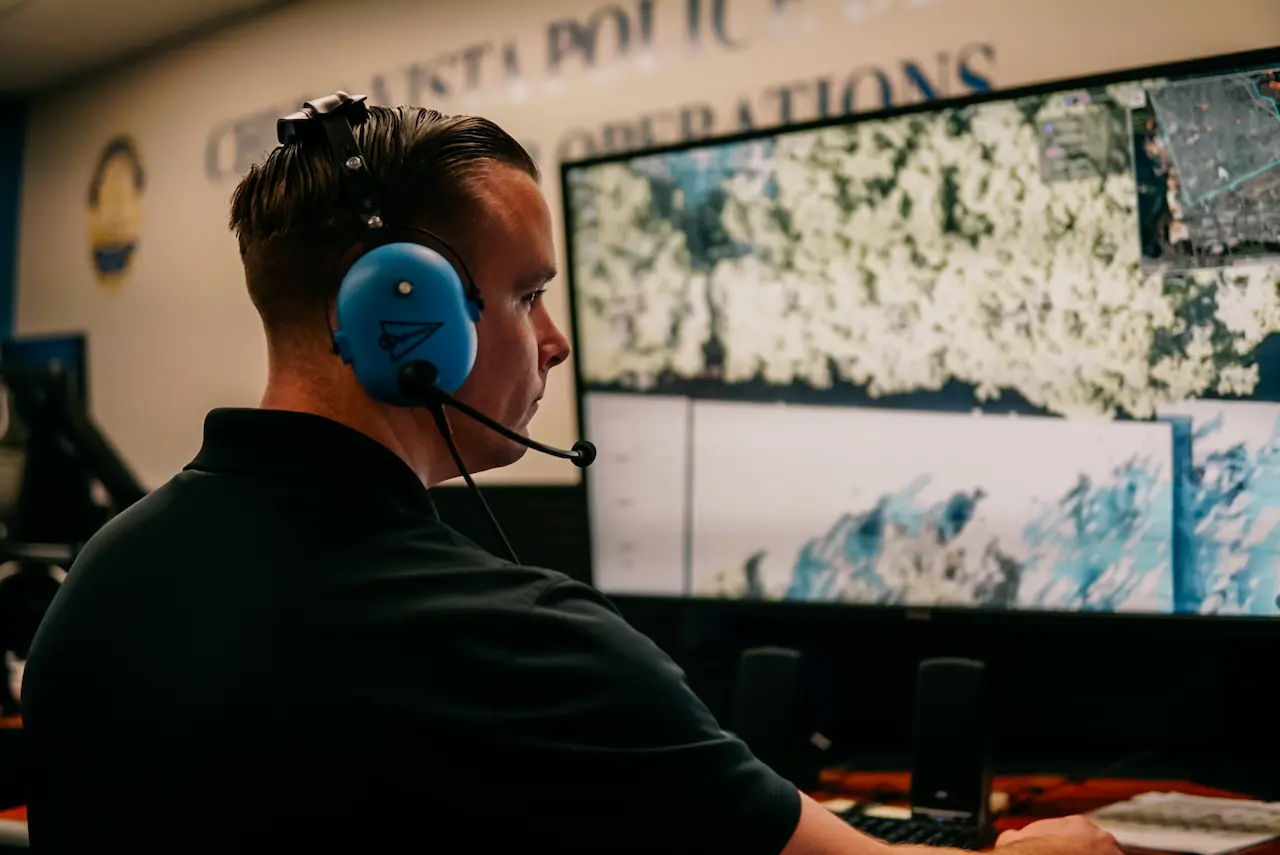California police departments have led the charge in leveraging drone technology to enhance public safety operations. At the 2024 Aerial Evolution Association of Canada Conference and Exhibition, officers from Chula Vista Police Department and Beverly Hills Police Department and industry expert Barry Brennan of Flying Lion shared their insights on the life-saving potential of uncrewed aircraft systems (UAS) in law enforcement. The panel highlighted the critical role of UAS technology in modern policing, particularly for emergency response and crime prevention. Discover their innovative approach to law enforcement, which has set a new standard for public safety agencies across the globe.
Drones to the Rescue: Real-Life Incidents
A picture paints a thousand words – and these word pictures of real-world incidents shed light on the true value of employing drone technology in public safety.
Fiery Highway Collision
In a dramatic rescue operation, Chula Vista Police Department’s drone program proved its worth during a severe vehicle collision on a highway. The incident involved a trapped occupant whose legs had caught fire. Due to the rapid deployment of a drone, officers were able to quickly locate the exact position of the crash, remove the victim from the burning vehicle and guide first responders to the scene.
Lieutenant John English, who manages Chula Vista PD’s drone program, emphasized the critical role of the drone in this rescue. “If we had not been there as quickly as we were, that person would have perished in the vehicle,” he explained. Thanks to the heroism of the officers on scene and drone technology, the victim survived this horrific incident.
Hotel Standoff Resolution
The Beverly Hills Police Department deployed drone technology to help resolve a potentially deadly encounter at the Waldorf Astoria hotel. An armed individual had been firing shots inside the hotel, which created a high-risk situation for officers and civilians alike.
The department’s drone provided crucial aerial surveillance, both in and outside of the building. This allowed officers to evacuate the entire floor safely and negotiate with the suspect.
A drone sweep of the subject’s hotel room before officers entered it also allowed them to ensure his safety, and their own.
Lieutenant Todd Withers, who commands the UAS/Drone program at Beverly Hills PD, noted, “The visuals from the drone gave us the intel we needed to allow us to evacuate the entire floor safely and get the subject out.” He had been shooting, but the drone showed that the subject had put the gun down at the officer’s request. Officers resolved this high stakes incident without escalation, injury or loss of life.
The Value Proposition
Barry Brennan, CEO and co-founder of Flying Lion, a company that specializes in drone services and training for public safety, added context to these incidents. “What we’re seeing here is just the tip of the iceberg,” he said. “Drones are providing a level of situational awareness that was previously unattainable. This allows first responders to make more informed decisions in critical situations.”
Integrating drone technology with existing public safety systems can complement and enhance traditional emergency response. “When integrated with command and control systems,” Brennan said, “drones become a force multiplier, providing real-time intelligence that can save lives.”
Beyond Emergency Response: Expanding Applications
While emergency response remains a primary use case, public safety agencies have found additional ways to leverage drone technology to save lives across other missions.

Search and Rescue Operations
Drones equipped with thermal imaging cameras have proven invaluable in search and rescue (SAR) missions, especially in challenging terrains or low-light conditions. They can cover large areas quickly and detect heat signatures that might be invisible to the naked eye.
Recent technological advancements in this area have made drones even more effective for SAR missions. Brennan highlighted that drones equipped with AI-powered search algorithms can now autonomously identify potential victims. This should significantly reduce search times in critical situations. Integrating drone-captured data with advanced command center software also allows for real-time sharing of aerial imagery and thermal data with search teams on the ground. This will dramatically improve coordination and effectiveness.
Traffic Management and Accident Investigation
For traffic management, drones offer a bird’s-eye view of congested areas. This helps officers make informed decisions about traffic flow. In accident investigations, aerial imagery can provide crucial evidence and help reconstruct crash scenes more accurately and efficiently. What used to take hours to document a crash site now takes, in some cases, minutes. This translates to fewer road closures for the public.
Disaster Response and Assessment
In the aftermath of natural disasters, drones can quickly survey damaged areas, assess infrastructure integrity and help responders to coordinate relief efforts. The birds’ eye view from a drone allows agencies to allocate resources more effectively and also to identify potential hazards that might not be visible from the ground. On the latter, Brennan noted, “We’ve employed specialized payloads for disaster response, including gas detection sensors and radiation monitors. These tools allow first responders to assess hazardous situations without putting themselves at risk.”
Some agencies employ enhanced drone response capabilities with LTE-enabled drones that provide continuous video streaming from disaster zones. “Even when traditional communication infrastructure has been compromised, we can ensure that command centers have uninterrupted access to critical information during large-scale emergencies,” Brennan said.
Overcoming Challenges: Lessons from the Field
While the benefits of drone programs have been proven time and again,successfully implementing them presents some challenges. Chula Vista PD and Beverly Hills PD, together with industry partners, have navigated these hurdles. They offered these nuggets of wisdom for other agencies considering similar programs.

Community Engagement and Transparency
Proactive community engagement has been a key factor in the success of these programs. Chula Vista PD, for instance, took an inclusive approach by engaging with various stakeholders, including those traditionally critical of law enforcement. Lt. English explained, “We engaged with all folks, those that you consider pro or adverse to law enforcement, different interest groups, the ACLU. We allowed everybody to speak to our program.” This inclusive approach helped shape their policies and gain community support.
Transparency was also key. Chula Vista PD created interactive dashboards accessible to the public, where it publishes comprehensive information about its drone program. To do this, Chula Vista utilizes several data sharing tools. These include features such asa flight logs, mission reports, and live streaming capabilities for certain operations. According to English, this level of openness has been crucial in building and maintaining community trust in these programs.
Brennan emphasized the importance of sharing not just the data, but the true return on investment of drones, with the public. “Transparency isn’t just about building trust; it’s about demonstrating the value of these programs to the community,” he said. “When people see how drones are being used to save lives and improve public safety, they’re much more likely to support these initiatives.”
Policy Development and Adaptation
Drones are unique and may not squarely fit into existing agency policies and procedures. Sometimes agencies struggle when they try to apply existing policies to drone operations. “It’s essential to develop drone-specific policies that address the unique capabilities and potential concerns associated with this technology,” Brennan warned.
In this regard, perhaps more so than with other technologies, addressing community concerns in drone policies is vital. For example, two main community requests helped to shape Chula Vista PD’s policy: drones should never be weaponized and they should not be used for random surveillance.
It’s also important to note that these policies are not “one and done.” Lt. English emphasized the importance of adaptability in policy-making. “Our policies are living documents,” he noted. “We’re constantly reviewing and updating them based on our experiences and community feedback. It’s crucial to stay ahead of the curve and anticipate potential issues before they arise.”
Comprehensive drone policies should not only address operational aspects but also data management, privacy protection and integration with existing systems. Brennan footstomped that “it’s about creating a holistic approach to drone program management.”
Training and Team Building
Both departments stressed the importance of providing comprehensive training. Chula Vista PD, for example, implemented a rigorous training program consisting of monthly mandatory training sessions and 40 hours of DFR training for all UAS pilots annually. This ensures that their pilots maintain proficiency and stay current with evolving technology and regulations.
Brennan, whose business provides such training, shared his perspective on the most successful drone programs. “They invest heavily in ongoing training. It’s not just about flying the drone; it’s about understanding how to integrate aerial data into decision-making processes and operational procedures,” he said.
And training comes in many forms including virtual reality training simulations to allow drone operators to practice complex operational scenarios in a safe, controlled environment. This type of immersive training helps operators to develop the skills needed to operate effectively in high-stress situations.
The Future of Public Safety Drones
As drone technology continues to advance, public safety agencies continue to explore new ways to leverage these critical assets. The panel outlined some potential areas of future development. Advanced AI and machine learning integration for automatic threat detection and tracking ranked high on the public safety wish list, as did improved thermal imaging capabilities for SAR operations. Panelists projected that enhanced drone swarm technology will change the game to coordinate responses to large-scale incidents. Finally, we should expect integration with other emerging technologies such as 5G networks and smart city infrastructure.
Brennan shared that Flying Lion is working on deploying autonomous drone systems that can be deployed automatically in response to 911 calls (or Drone As First Responder). “These systems could provide real-time situational awareness to first responders before they even arrive on scene,” he said.
The panelists also envision a seamless ecosystem where drones are just one part of a larger, interconnected public safety network. This could include integrating drone data with body-worn cameras, in-vehicle systems, radios, license plate recognition and command center software to provide a comprehensive operational picture.
Lt. English added, “We’re just scratching the surface of what’s possible with drone technology. As these systems become more sophisticated and integrated, they’ll become an indispensable tool for law enforcement and public safety.”
A New Era in Public Safety
From life-saving rescues to enhanced situational awareness, drones continue to prove their worth in real-world public safety scenarios. As more agencies across the country look to implement their own drone programs, the lessons learned from these pioneering departments and industry experts provide a guide for law enforcement agencies that seek to harness the full potential of drone technology to serve and protect their communities more effectively. The bottom line: focus on transparency, engage the community and continuously improve policies and training.
Lt. Withers concluded with an optimistic outlook. “The future of law enforcement is in the air,” he said. “Drone technology, when implemented responsibly and effectively, has the potential to significantly enhance public safety while building stronger, more transparent relationships with our communities.”
As we look to the skies, it’s clear that drones are, and will remain, true public safety partners in helping to save lives and protect communities.
Potential areas of future development of drones in public safety include:
- Advanced AI and machine learning integration for automatic threat detection and tracking
- Improved thermal imaging capabilities for SAR operations
- Enhanced drone swarm technology for coordinated responses to large-scale incidents
- Integration with other emerging technologies such as 5G networks and smart city infrastructure

